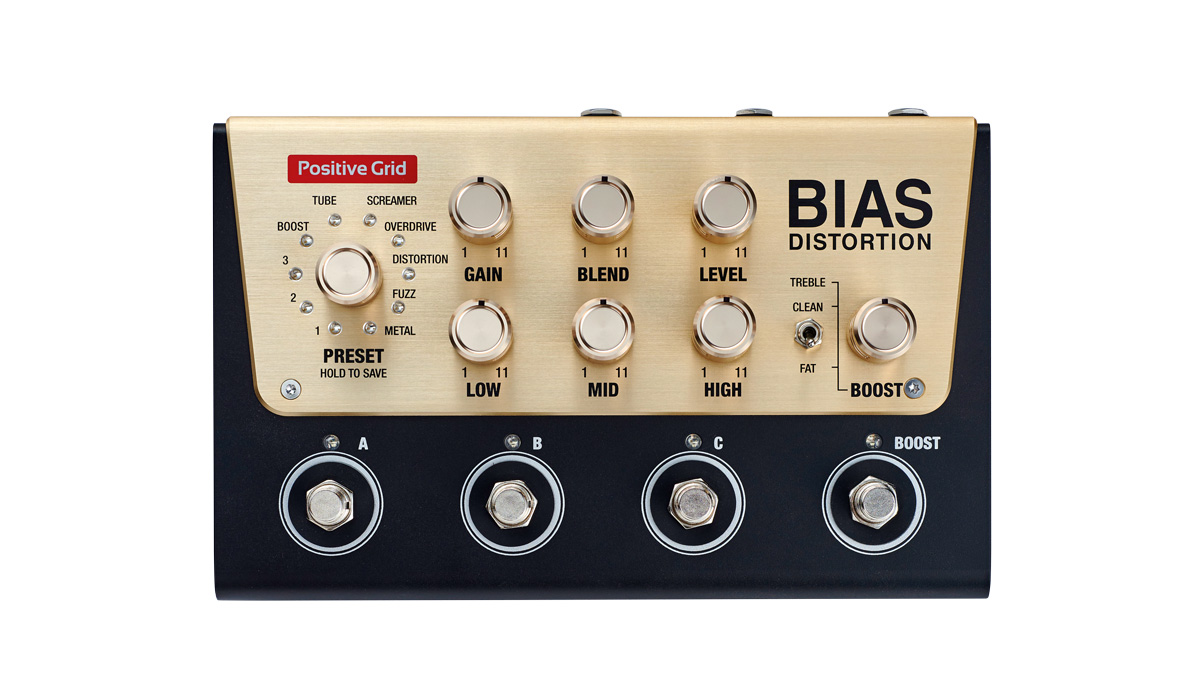MusicRadar Verdict
Tonal tinkering to your heart’s content.
Pros
- +
Instant footswitching of three distortion effects.
Cons
- -
Boost switching seems to have a time lag.
MusicRadar's got your back
Positive Grid’s roots are in the software field starting with its JamUp app, through its various BIAS amp sim and effects iterations.
More recently, though, the company has made a move into the hardware world and the BIAS Distortion Pro is its first pedal: a distortion/overdrive that is allied to its BIAS Pedal software (mobile and desktop), effectively allowing you to design your own virtual distortion pedal and load it into the hardware pedal.
The pedal comes with two banks of 10 programmable presets that are accessed from its front panel, any three of those presets being easily assignable to a set of three footswitches for direct call-up. A fourth footswitch operates a boost that can be placed before or after the distortion and can be set for a full-frequency clean boost, treble boost or a fat midrange boost.
Presets are selected from that switch and you get six knobs to tweak them; a press/hold on the switch will save any changes you make into memory
The pedal comes with a power supply that plugs into its USB port and it can also run from your usual nine-volt pedalboard power supply.
Build quality is solid enough, although the turn-and-press preset selector rotary switch feels a little fragile. Presets are selected from that switch and you get six knobs to tweak them; a press/hold on the switch will save any changes you make into memory. Low, Mid and High EQ knobs are pretty standard, as are the knobs for Gain and Output Level, but the Blend knob is a more unusual feature that tweaks the mix ratio of the output stage - one of the tone-shaping modules that the pedal sounds are built from, offering a range of blends.
Sounds
As shipped, the pedal’s presets offer options that adequately cover the sounds of a range of generic dirt pedal types, several being based on well-known units: Tube Screamer, Fuzz Face, and so on.
As an initial set of sounds to be used straight out of the box, you may find some that are instantly playable without any tweaks, but they all represent a starting point for tweaking with the knobs to get them more aligned with your personal taste.
More nuanced options, however, emerge when you make the connection (USB or Bluetooth) between the physical pedal and the software (a redeem code for the BIAS Pedal software is included in the package) where you really can get into the nitty gritty of creating customised sounds.
You start with one of the 20 named pedals (seven distortions and overdrives, five fuzzes and three boosters), then have a series of modules (Custom Panel, EQ 1, Clipping Stage, Output Stage, EQ 2, Power Module) with a range of parameters to adjust. You can, for example, change a pedal’s topology in the Clipping and Output stages, choosing Germanium or Silicon transistors, JFet, MosFet or valves. Furthermore, the graphic EQs offer really powerful tonal shaping. There’s also a Tone Match function that compares the onboard sound with your own favourite pedals and dials in tonal compensation to create a close facsimile.
As shipped, the pedal’s presets offer options that adequately cover the sounds of a range of generic dirt pedal types
In addition, you can use the online ToneCloud facility to share custom tones and download other users’ creations for your own pedal. One thing you can’t do is stack distortion sounds because only one of the three footswitches (A, B, C) is active at one time.
Still, there is practicality in that setup as you can easily set up the pedal for having three variations of the same distortion type, perhaps with increasing amounts of gain, or set it up for three different effects - maybe a low-level drive, a heavy distortion and a fuzz, making it a very useful workhorse for live use - enhanced even further by the Boost switch.
We did find, however, that there was a bit of a time lag on the boost switching. Further control comes courtesy of plugging in an expression pedal, which can be set to control multiple knobs. MIDI control is also a possibility as the pedal supports all of the standard MIDI commands for instant Program Change access to all 20 presets and Control Change access to parameters.
There are some pretty stellar multiple distortion pedals on the market now - such as Strymon’s Sunset, the Chase Bliss Brothers and the Elektron Analog Drive - so the BIAS Distortion Pro does face some tough competition out there. Its software programmability, though, might just be the deal-maker that will turn some players in its direction.
Trevor Curwen has played guitar for several decades – he's also mimed it on the UK's Top of the Pops. Much of his working life, though, has been spent behind the mixing desk, during which time he has built up a solid collection of the guitars, amps and pedals needed to cover just about any studio session. He writes pedal reviews for Guitarist and has contributed to Total Guitar, MusicRadar and Future Music among others.
Why is tennis superstar Serena Williams being bombarded with microphones fired from confetti cannons? Allow us to explain…
Carlos Santana collapses and then cancels second show “out of an abundance of caution”
“Every post feels like a test. If it flops I feel like a failure”: 61% of DJs feel that their social media presence is more important than their skill











